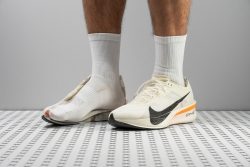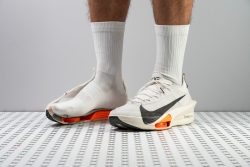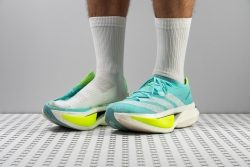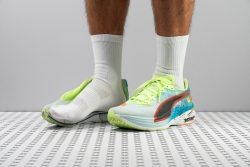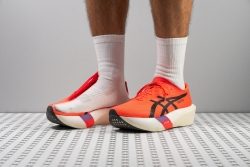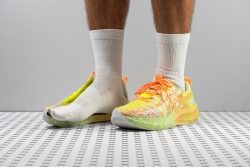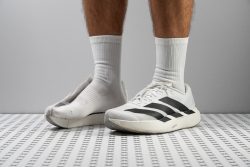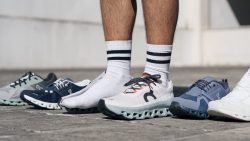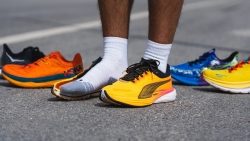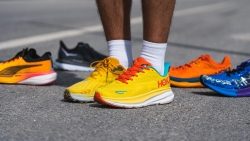7 Best Triathlon Running Shoes in 2025

We buy shoes ourselves. We earn commissions when you buy through us, at no extra cost. Why trust us
From quick-lace capability and comfort to durability and breathability, the best triathlon running shoes need to have it all. Triathletes need to have the right running shoes and support to maximize their performance. In the guide section, we cover all the shoe features that are important for triathletes, and we talk about how to recognize the shoe that can satisfy all of your cravings.
To help you choose the right pair of shoes for your upcoming triathlon, we’ve handpicked our top picks in different categories. After thorough testing on the road and in the lab, we selected our favorites, from the best overall and on-road performance to the best budget-friendly options.
How we test triathlon running shoes
Our entire approach to reviewing triathlon running shoes involves these steps:
- We use our own funds to purchase all the shoes for this review. This is to keep us free from any bias, brand loyalty, and all that.
- We bring the shoes to our independent testing lab. We cut them open and measure 20+ parameters, including energy return, shock absorption, outsole thickness, durability, and breathability.
- We test each model in high-mileage training and racing conditions to assess its actual road performance and determine its strengths and weaknesses.
Best triathlon running shoes overall






















































What makes it the best?
We ran with many triathlon running shoes in search of the best overall — and it’s none other than Nike’s Vaporfly 4. This record-breaker feels like it’s barely there and delivers unparalleled responsiveness for that podium finish. The comfort and stability of this hypersonic shoe make it a great racer, even for a half-Ironman.
Weighing 5.9 oz (166 g), it’s feathery light compared to other racers that average 7.8 oz (208g). With less weight, it prevents fatigue and boosts our agility.
Vaporfly 4 has a moderate stack combined with the soft and responsive 19.9 HA ZoomX foam, which makes our off-the-bike runs comfortable. It’s a leg-saver that allows us to maintain a strong and consistent pace over long-haul efforts.
Meanwhile, the stiff Flyplate promotes energy return and stability. Our bend test confirms it’s 14.6% stiffer than average. Combined with the balanced stack, we felt quite surefooted throughout testing.
The pleasantly breathable upper also contributed to the light feeling. Smoke escaped easily in our lab test, earning it an impressive 4/5 rating. This prevents sweat and heat build-up and blisters.
However, those racing full Ironman distances may want to think twice about this shoe. Its near-average 34.1/25.5 mm stack may not feel cushioned enough for a full marathon.
Pros
- 13% lighter than the Vaporfly 3
- Awesome for 5K, 10K and 21K races
- Full ZoomX midsole
- Spring-loaded carbon-fiber Flyplate
- Fantastic lockdown with premium laces
- Moderate rocker for a more natural ride
- Improved perforated, removable insole
- Better rubber coverage in the forefoot
- Gets improvements from the Alphafly 3
- Great upper featuring breathability and durability
Cons
- Less ideal for marathon racing
- Still lacks the snappy feel of the Vaporfly 1&2
- Narrow midfoot and heel limit stability
Best triathlon running shoes for Ironman
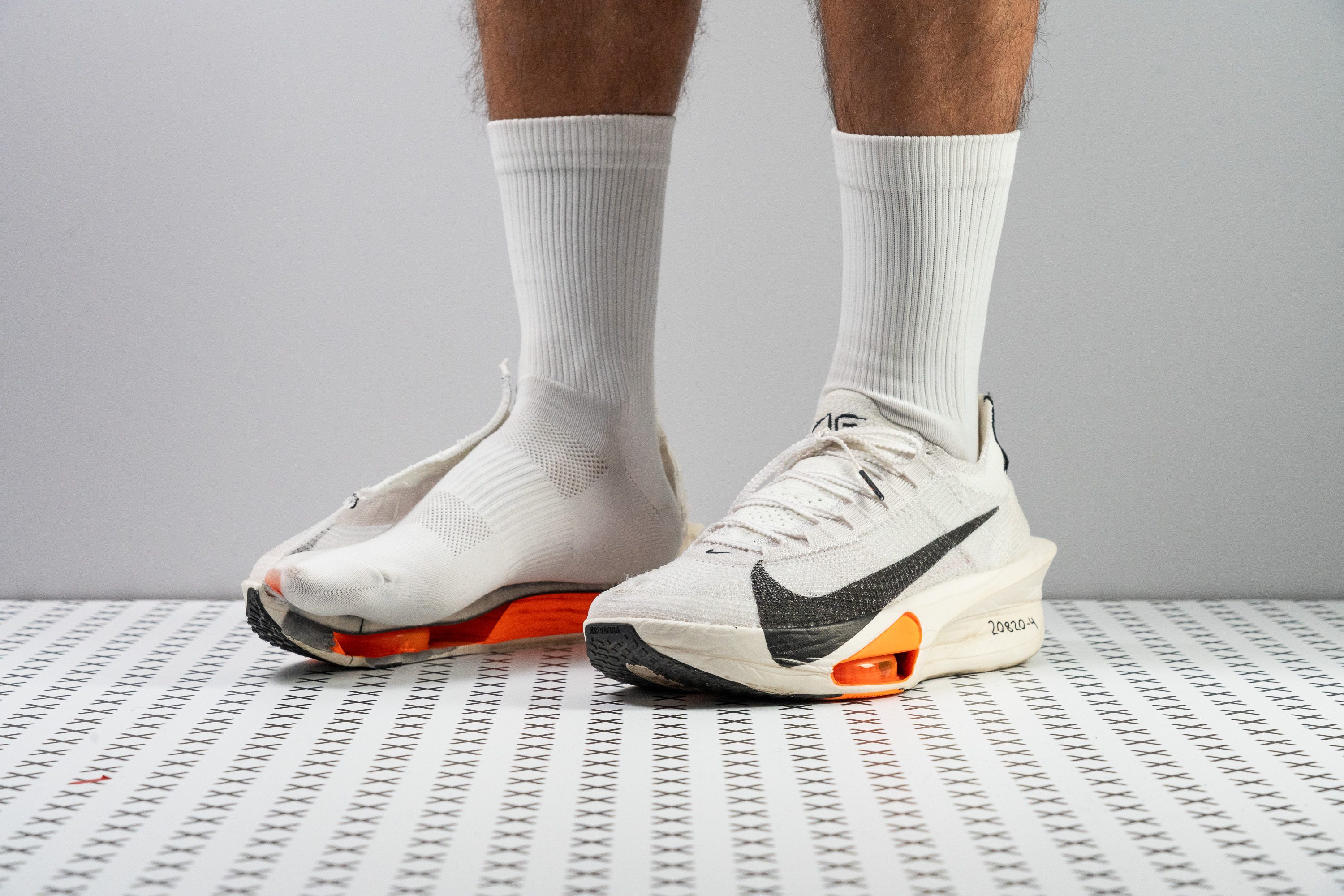









































































What makes it the best?
With outstanding ratings from our lab and runners, Alphafly 3 proves it's a leg-saving, responsive, and breathable shoe. It delivers much-needed support and unwavering resilience that shines even better in long distances, making it the best for Ironman among triathlon running shoes.
We noticed this racer's strong and consistent energy, promoting smooth turnovers. We cut the midsole in half and found the FlyPlate and Air Pods integrated into the foam. These made our off-the-bike runs effortlessly fast! Proven by our 30° bend test, it emerged 89.3% stiffer than average, translating to a strong energy return.
This max-cushioned shoe provides comfort for brutal miles. Alphafly 3 features the world-renowned ZoomX midsole, that’s both bouncy and plush. This shoe elevates it further by adding a firm 29.3 HA top layer to enhance stability, which is crucial when our running form starts to change as the fatigue kicks in.
Alphafly 3 is a breath of fresh air, literally! The shoe sits at a feathery 7.1 oz (201g) vs. the 7.5 oz (214g) average racer. We’re amazed at how stacked and light it is simultaneously! On top of this, it has a well-ventilated upper that secured a perfect score on our breathability test.
However, we don’t recommend wearing this shoe sockless as the Atomknit has a slightly rough texture that may cause blisters.
Pros
- Remarkably lightweight despite its broad size
- Best-in-class breathability
- Excels in the marathon distance
- Repositioned Air Pods offer a better ride than the v2
- ZoomX foam delivers massive energy return
- Aids in forward momentum, especially when legs begin to fatigue
- Better than ever for 5K/10K racing
- Finally smooth transitions!
Cons
- Heel strikers might wear down the outsole quickly
- The arch could still be a challenge for some
- The sock-like tongue might not suit everyone
Triathlon running shoes with the best shock absorption
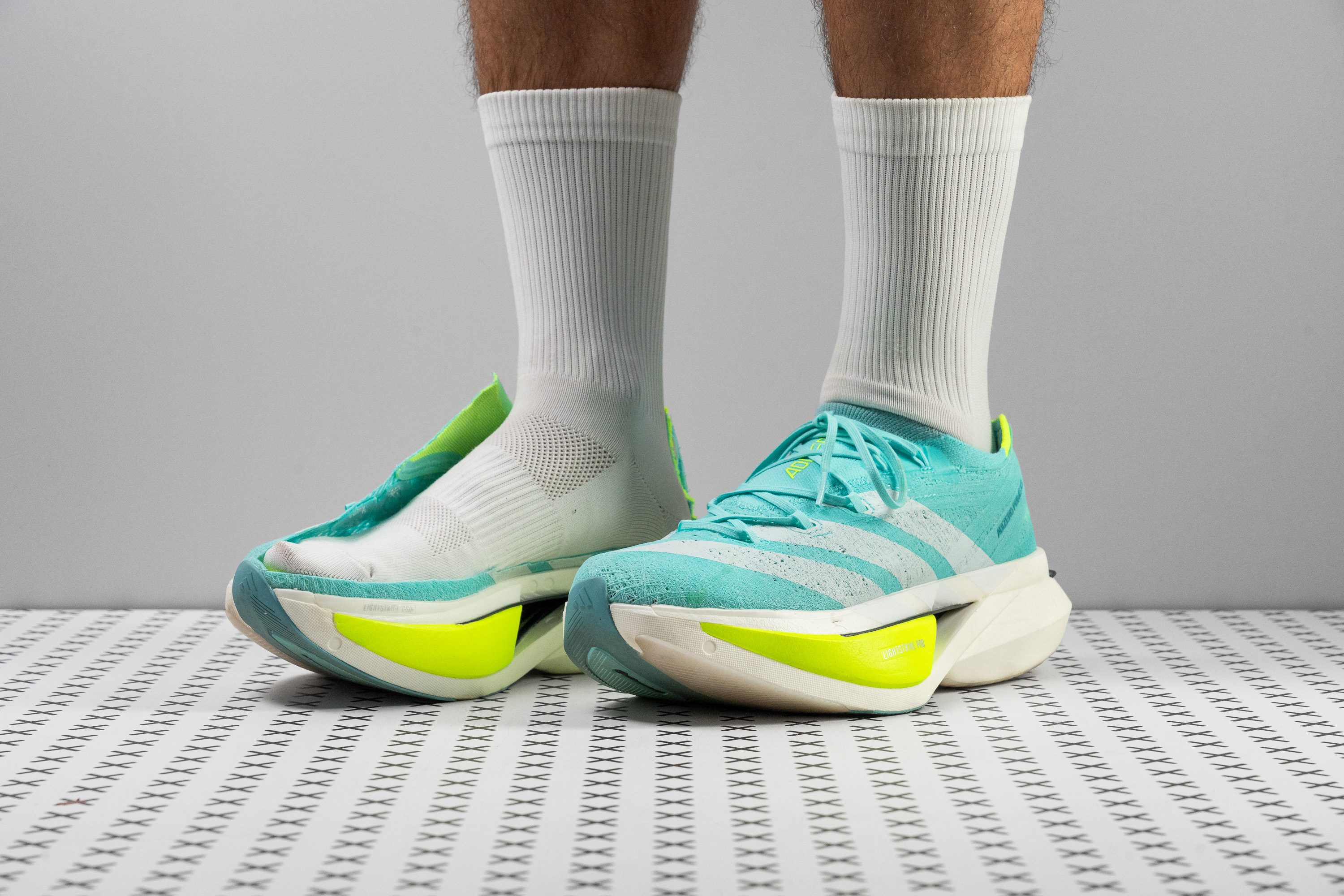





















































What makes it the best?
Among the triathlon shoes we ran with, the Adidas Adizero Prime X3 STRUNG delivers the best shock absorption while maintaining consistent leg-saving support, exceptional power, and unmatched comfort. With record-breaking lab results, it proves that fast shoes can feel good on foot.
Our off-the-bike runs feel more bearable with the elite-level midsole. It offers bottomless cushioning, rising to an otherworldly stack height of 48.1/35.1 mm, the forefoot even exceeding the average running shoe’s heel.
Built with Lightstrike Pro formulation, we measured the heel’s shock absorption at a massive 160 SA, meaning it reduces the forces of road running by 25.0% vs. average.
This speedster is the wind beneath our wings, with its cutting-edge technology and responsive midsole. Testing for energy return, we recorded above-average scores of 73.7% in the heel and 76.7% in the forefoot. At this level, it feels more natural to run in the PX3 at faster paces. The positioning of the plate and Energy Rods 2.0 adds stiffness and responsiveness to the ride.
While we appreciated its maximum torsional rigidity, enhancing stability, its wild longitudinal stiffness meant fighting the shoe a lot to bend our feet. It emerged as the stiffest shoe in our lab, 156.7% above average, so we can’t recommend this to triathletes seeking agility and a relaxed feel.
Pros
- Excellent shock absorption
- Fantastic bounce from new Lightstrike Pro foam
- Fits better than v2
- Innovative tech and design from heel to toe
- STRUNG upper is just awesome
- Works well on any season
- Skyscraper-like stack height
- A total blast (if it suits you)
- Breathable upper
Cons
- Crazy expensive
- Heavier than all supershoes
- Heel strikers may feel unstable
- Too stiff for easy days
Triathlon running shoes with the best energy return
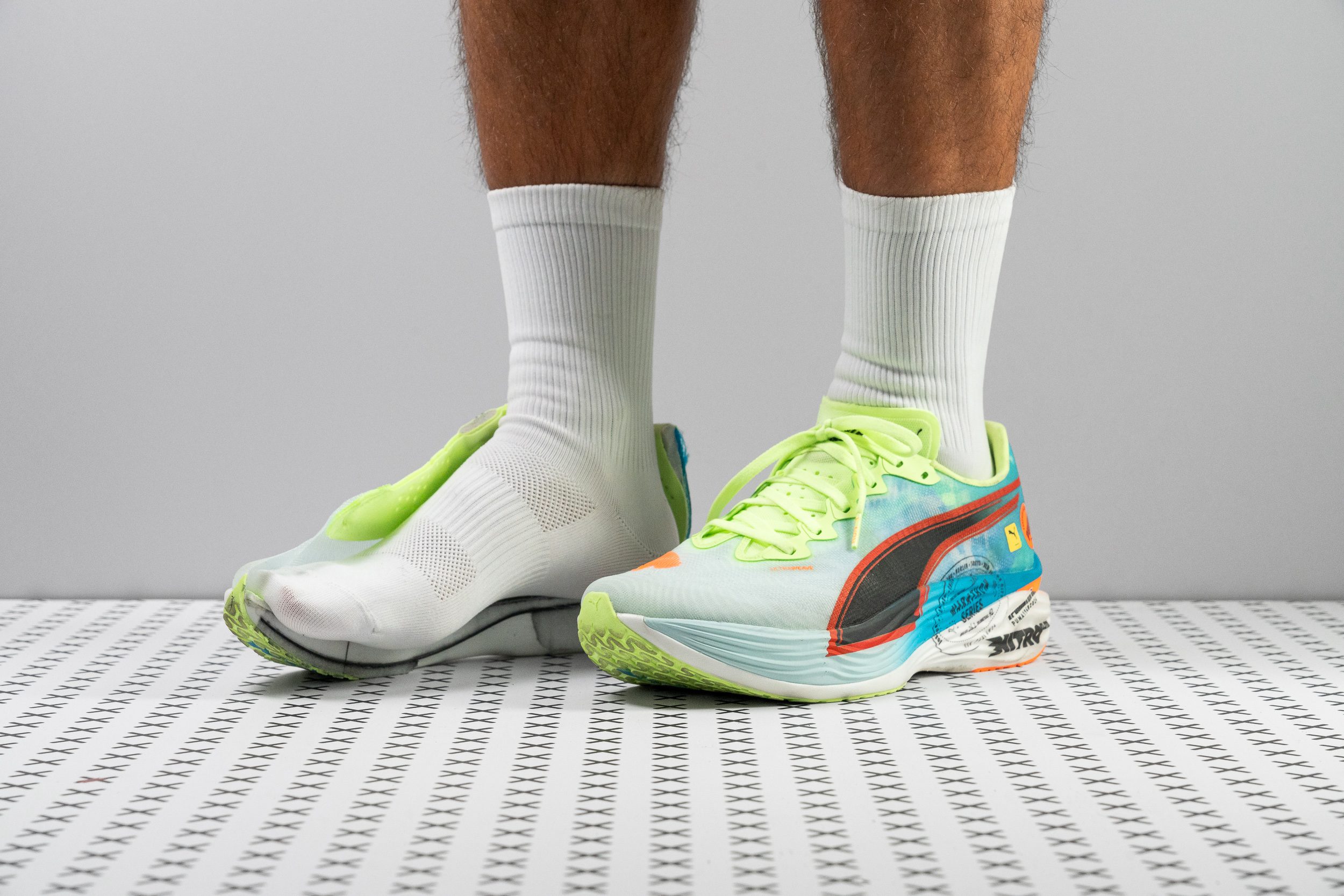





























































What makes it the best?
The PUMA Deviate Nitro Elite 3 has a soothing yet electric aura that helps keep our legs fresh as we conquer the final section of brutal triathlon sessions. Among running shoes from this category, the DNE 3 claims the top spot for energy return. Besides its responsiveness, we discovered in the lab that it packs tons of cushioning and elite traction in its lightweight build.
Besides its stiff carbon plate, we credit the Nitro Elite foam for its super-shoe-level rebound. In our energy return test, we recorded high ratings of 77.1% (heel) and 76.3% (forefoot), a level only a few shoes can match. In addition, its weightless 7.2 oz (204g) build helps with quick turnover and prevents additional fatigue.
The midsole is muscle-friendly and kind to our already tired legs after the swim and bike portions. We measured the stack height at a generous 39.2/28.6 mm, and it offers more leg protection than average. In our shock absorption test, DNE 3 impressed us with 147 SA (heel) and 124 SA (forefoot).
The PumaGrip’s relentless bite to the ground gave us control, regardless of road conditions. In our wet-condition test, it proved itself 45.7% grippier than average with its 0.67 friction score. However, it surrendered easily to our Dremel. Best to save this shoe for racing to prolong its life.
Pros
- Superb Nitro Elite foam
- Breathable, lightweight upper
- Extremely responsive
- More affordable than most supershoes
- Outstanding grip
- Great comfort for a racer
- Major improvements from v2
- Fast, agile, race-ready performance
- Fantastic tongue
Cons
- Not the best for heel strikers
- Durability concerns
- Lacks stability for some runners
Best lightweight triathlon running shoes




















































What makes it the best?
We ran with many triathlon running shoes in search of the best lightweight choice—and it’s no other than ASICS Metaspeed Edge Tokyo. This record-breaker feels like it’s “barely there” in our runs and delivers unparalleled responsiveness for that podium finish. The comfort and grip of this hypersonic shoe make it a great racer, even for a full Ironman.
Weighing 5.6 oz (159 g), it’s feathery light compared to other racers that average 7.3 oz (207g). Even with less weight, it still dominates races with unmatched energy return.
In the lab, we discovered the new FF Leap foam making waves, with its massive energy return scores of 78.3% (heel) and 76.8% (forefoot). It felt more natural to run fast in these shoes! The extra grippy outsole also boosted our confidence and control, whatever the weather, with a strong traction score of 0.74 in our wet-condition test.
Despite its airy nature, Metaspeed Edge Tokyo features a mega 38.9/32.0 mm stack that makes our off-the-bike runs comfortable. It’s a leg-saver that allows us to maintain a strong and consistent pace over long-haul efforts, proven by high impact protection scores of 146 SA (heel) and 132 SA (forefoot).
Those who are planning to cut costs will not be delighted with this shoe’s steep $270 price. Triathletes who find it too expensive can go for cheaper alternatives.
Pros
- Light as a feather
- Excels at any distance, from 5K to the marathon
- Elite-level traction
- New FF Leap midsole is super responsive
- More stable than the Metaspeed Sky Tokyo
- Plush forefoot
- Excellent upper
- Classic rolling feel from curved plate
- Better than Metaspeed Edge Paris in every way
Cons
- Price increase
- Narrow fit
- Not stable
Triathlon running shoes with the best traction
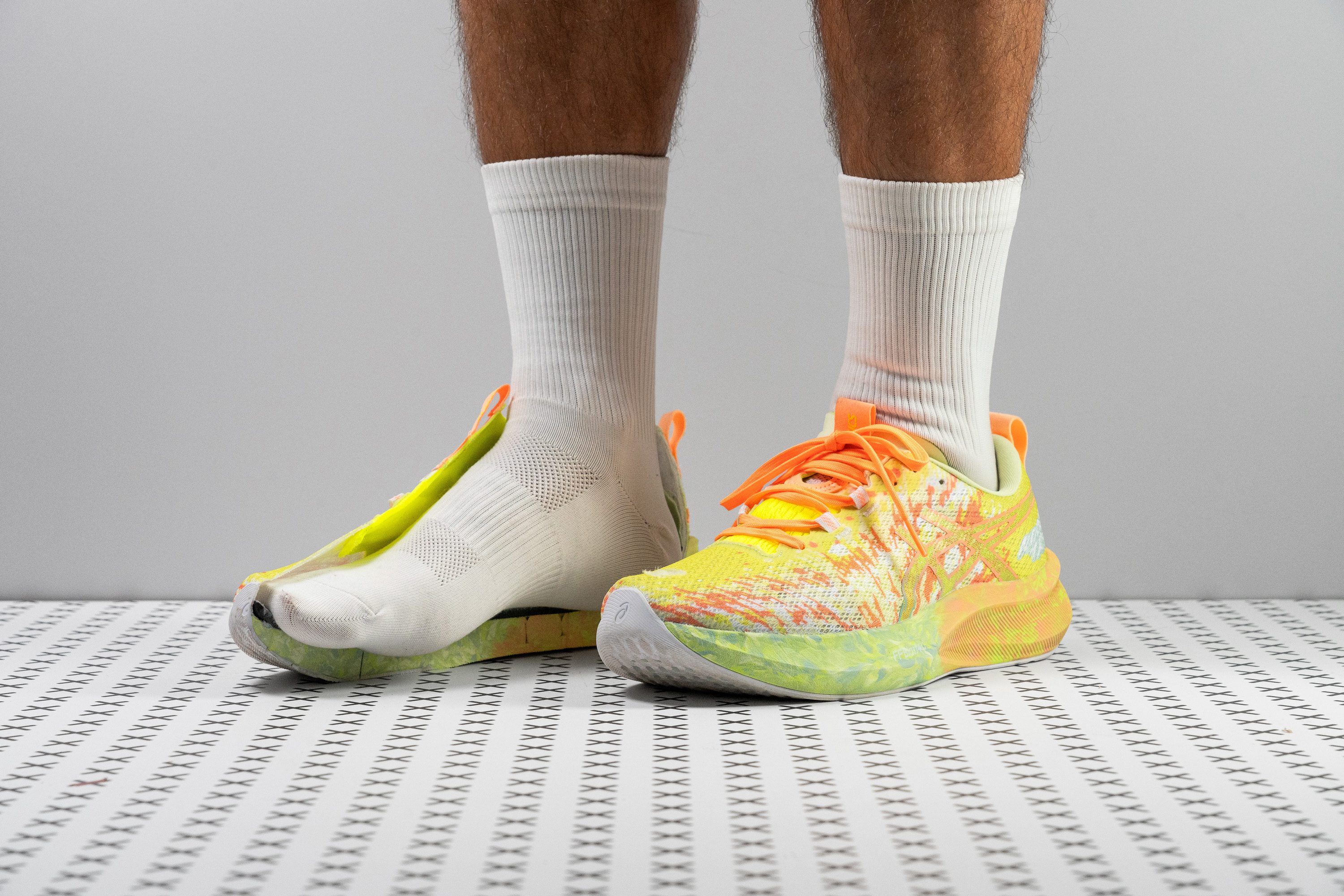





















































What makes it the best?
Noosa Tri 16 is an eye-catching, versatile shoe that offers relief and support in a lightweight package. It’s so comfortable that we can run many miles in it sockless—perfect for Tri(athlons). On top of this, lab results confirm its grippy outsole gave us controlled strides, making it our triathlon running shoe with the best traction.
We went straight to the lab and recorded a high score of 0.79 in our traction test, proving it’s 71.7% grippier than average, which makes it effective even on wet surfaces. What added more stability in our runs are the midsole sidewalls and sole flare of the 3D Guidance System.
Weighing 7.7 oz (217g), it’s on par with other lab-tested racers. It encourages effortless and efficient turnover—a great relief for our off-the-bike runs. Even on slower training days, we're equally at ease thanks to its natural feel. Our flex test validates it's slightly more flexible (14.6N) than average (15.0N).
The rejuvenating ride is enhanced by an airy mesh upper. Under our microscope, we saw large ventilation holes in the toebox, explaining its 5/5 breathability score. With zero friction, it felt comfortable to wear sockless—perfect for triathletes, saving precious transition time. Additionally, the heel and tongue include tabs for seamless slip-ons. However, the upper had no chance against our Dremel. Therefore, runners who tend to ruin toe boxes should explore elsewhere.
Pros
- Lightweight
- Exceptional grip
- Attention-grabbing aesthetic
- Gusseted tongue
- Comfortable upper
- Great for triathlon
- Really versatile
- Fantastic price point
- Breathability
Cons
- Upper longevity
- Minimal tongue padding
- Still not enough energy return
Best triathlon running shoes for tempo workouts
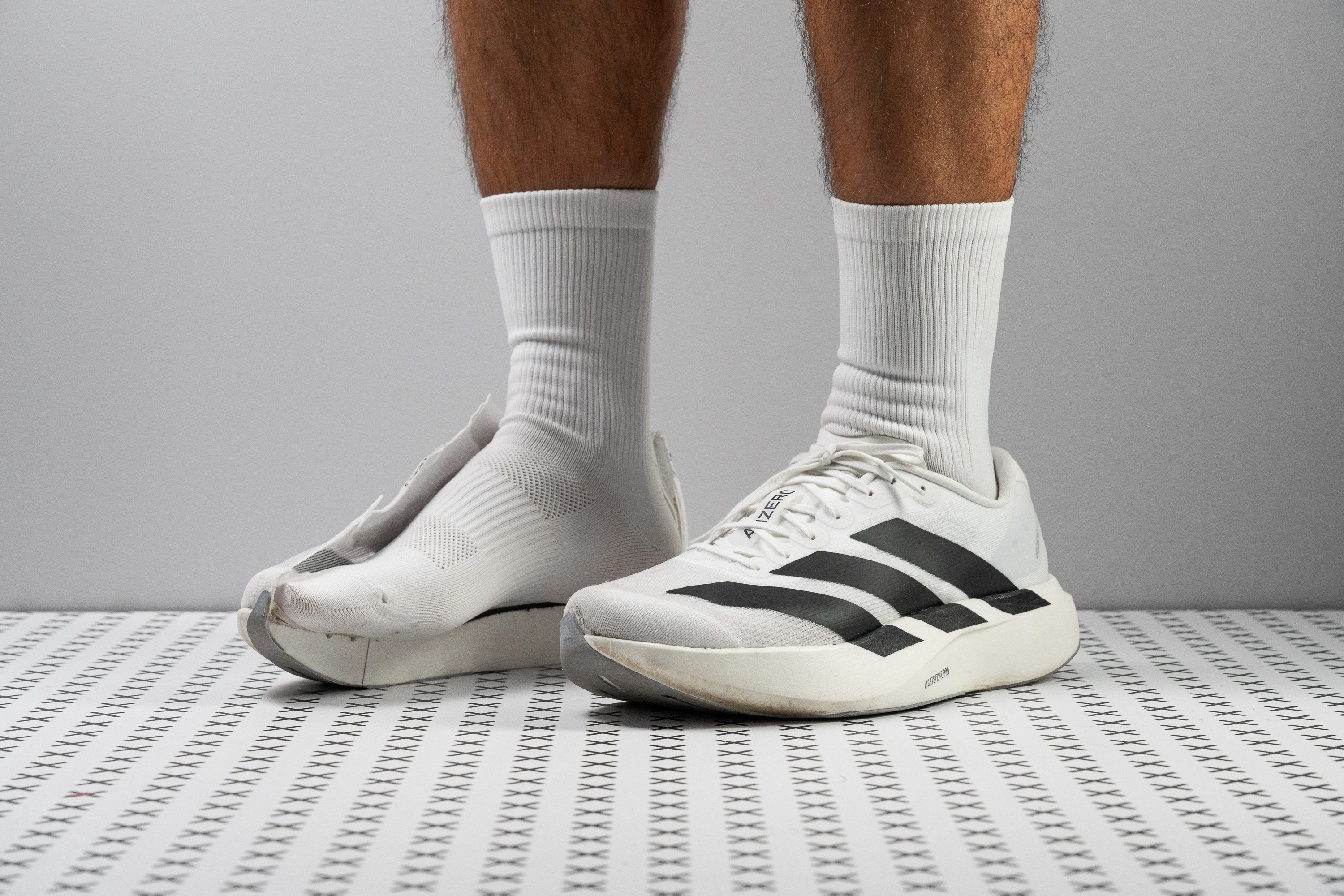































































What makes it the best?
Triathlons are demanding events and become even more grueling in the run portion. In this final stretch, efficiency is key, and we discovered in the lab a shoe that’s energetic yet so comfortable: the Adidas Adizero EVO SL. This featherweight is versatile and enjoyable across all paces, making it our top tempo trainer among triathlon shoes.
The Lightstrike Pro midsole deserves the spotlight. It delivers a steady stream of energy in our intervals, feeling vibrant with each toe-off and cushioned with each landing. We tested for its energy return and got superb scores of 74.3% in the heel and 70.3% in the forefoot, proving its springiness for any footstriker.
We handled longer workouts with ease since the cushion was protective enough for daily mileage. Its above-average 36.1/28.1 mm stack absorbed landing impact well, with high shock absorption rates of 147/126 SA.
The pair can double as a racer with its light weight of 7.9 oz (223g), 12.9% below average. Its airiness is further enhanced by its plate-free design, which boosts flexibility and comfort. In our bend test, it is indeed 34.7% more malleable than average.
As an effort to minimize weight, the tongue is a minimal 1.5 mm. We warn of lace bite, especially during long runs.
Pros
- 100% Lightstrike Pro superfoam
- Exceptional value-to-performance ratio
- Low weight
- Ultra-breathable upper
- Unmatched versatility
- Agile and fun ride
- Handles short and long runs with ease
- Striking Evo 1-inspired aesthetics
Cons
- Poor-quality laces
- Short, non-gusseted tongue
- Toebox durability
In this guide, we focus on triathlon running shoes that work for the most runners. There will be triathletes who run in minimalist or even barefoot running shoes, but that’s a niche group we won’t cover here.
6 features to look for in triathlon running shoes
If in doubt about what to prioritize when looking for new triathlon running shoes, here’s our 6-bullet list:
- Responsiveness. You want shoes to help you move forward after swimming and cycling! Premium foams steal the show, thanks to their energy return and leg-saving features.
- Great shock absorption to avoid unecessary extra stress sent to the legs.
- Easy-on! You should be able to slide into the shoes quickly. This means you might look for elastic (sock-like) upper around the ankle, elastic laces, thin tongue, and so on.
- Breathability = quick drying.
- If you run sockless, look for seamless lining or lining that’s as gentle as possible to your naked skin. Also, a tongue that does not bunch up once the shoe is tied is a must in order to avoid discomfort (from blisters to wounds).
- If you plan to walk a certain part of the distance, avoid carbon plates. They are not easy on the legs being uncomfortable and weird at walking paces.
Keep in mind that in most cases, these are race shoes (sometimes tempo shoes). That means they are most likely expensive and not so durable. We will cover all of these features in greater detail below.
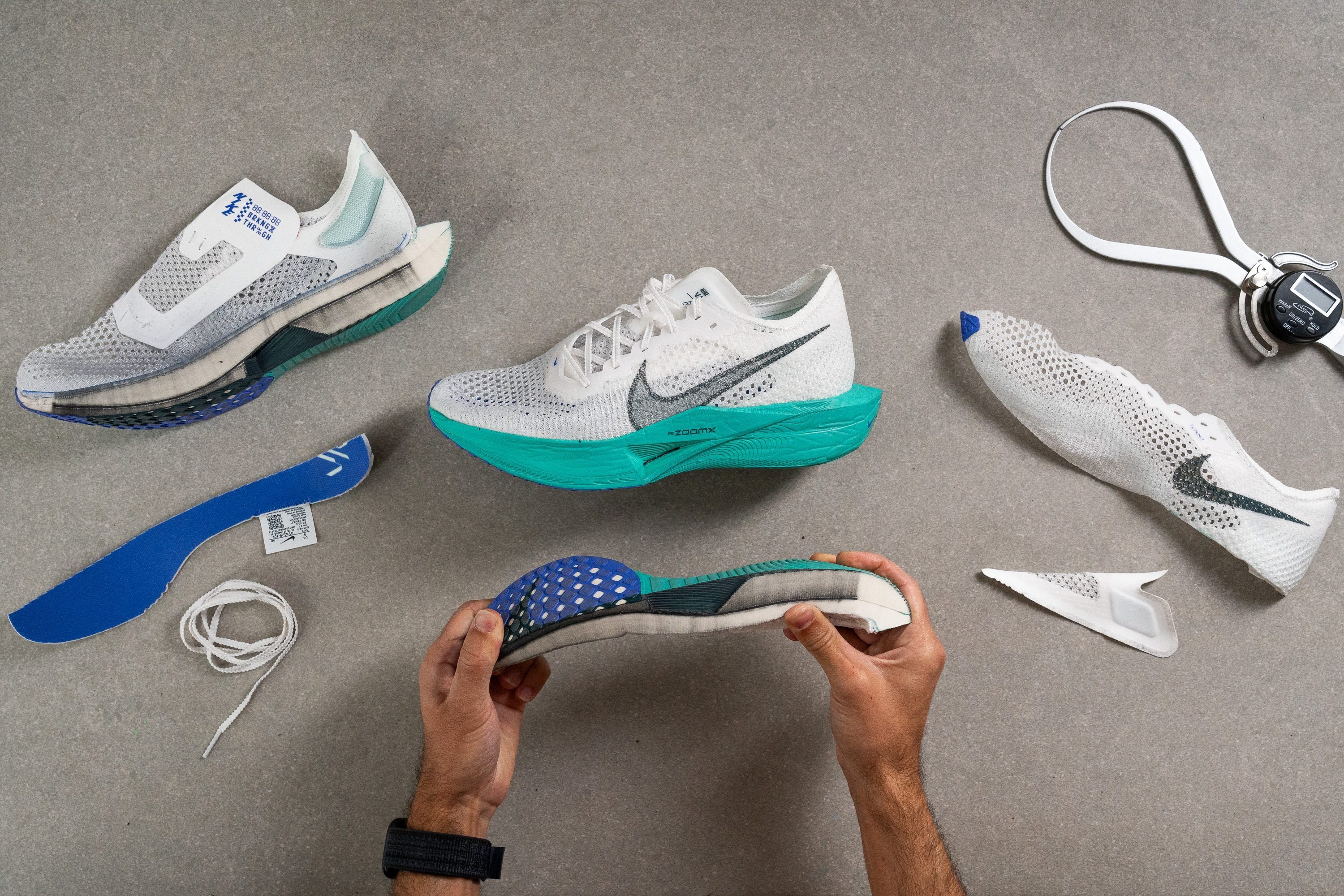
Why is energy return so important when running triathlons
After finishing the swim part and the cycling part, your legs are tired, to say the least. Ground feel at that point is not welcome at all, just like very dull foams that make your feet sink in and not bounce back.
If you want the best out of the best, we recommend looking for a running shoe with premium foam and a carbon-fiber plate.


Also, you can consult our energy return test results, which are much more straightforward than figuring out the foam and its properties. The higher the energy return (in %), the better!
Testing the energy return and shock absorption of triathlon running shoes (methodology used: SATRA TM144)
Shock absorption in triathlon running shoes
We recommend looking for at least 30mm at the heel or a shock absorption of at least 110 SA. Tired legs are eager to be cushioned and protected from the impact forces and we should give them that.
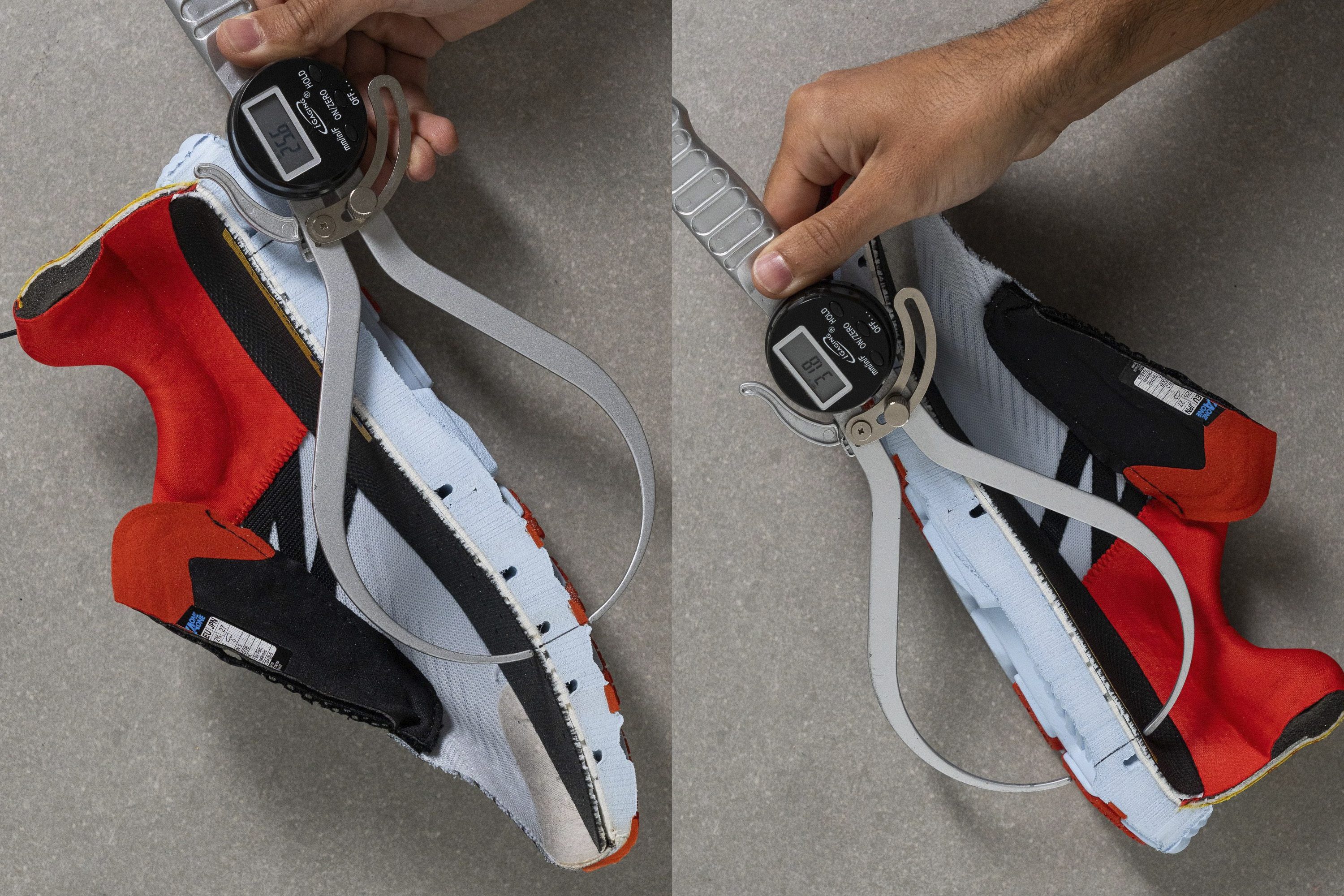
Running shoes that are low to the ground will make your feet more fatigued, especially if you’re not extremely used to them. It is important to note that Ironman’s new rules do not allow shoes with more than 40 mm at the heel. We also recommend looking for high shock absorption, as that will make your legs deal only with the race ahead and not extra stress that could be sent towards the legs because the midsole can't handle it.
Slide into your triathlon running shoes
To slide into your triathlon running shoes, they should feature some of the following features:
- Elastic laces
- Stretchy upper around the ankle
- Heel pull tab and/or tongue pull tab
However, many of the Asics Metaspeed running shoes are used on triathlons but they don’t feature the heel tab. It’s important to balance things: it could be worth spending a few seconds more on putting the shoe on if that means you get to run in a faster shoe that will be easier on your legs.
Breathability of triathlon running shoes
If doing a triathlon in very hot weather, chances are your feet will be sweaty from the bike ride, so you don’t want them to keep sweating in running shoes as well. Not just that, breathability and quick-drying of the upper are equally important whether you’re running with socks or sockless.

Socks can have moisture-wicking properties, but the upper takes the charge. Best when it’s as breathable as possible.
Testing the breathability of triathlon running shoes
In our lab, we test the breathability by pumping the smoke into triathlon running shoes. We then observe where the smoke comes out and how fast. Based on this, we assign a breathability rating on a scale of 1 to 5, where 5 is the most breathable.
To our pleasure, race shoes are the most breathable ones! Their average sits at 4.7/5.0, while the average breathability for tempo shoes and daily trainers sits at 4.3 and 3.6, respectively.
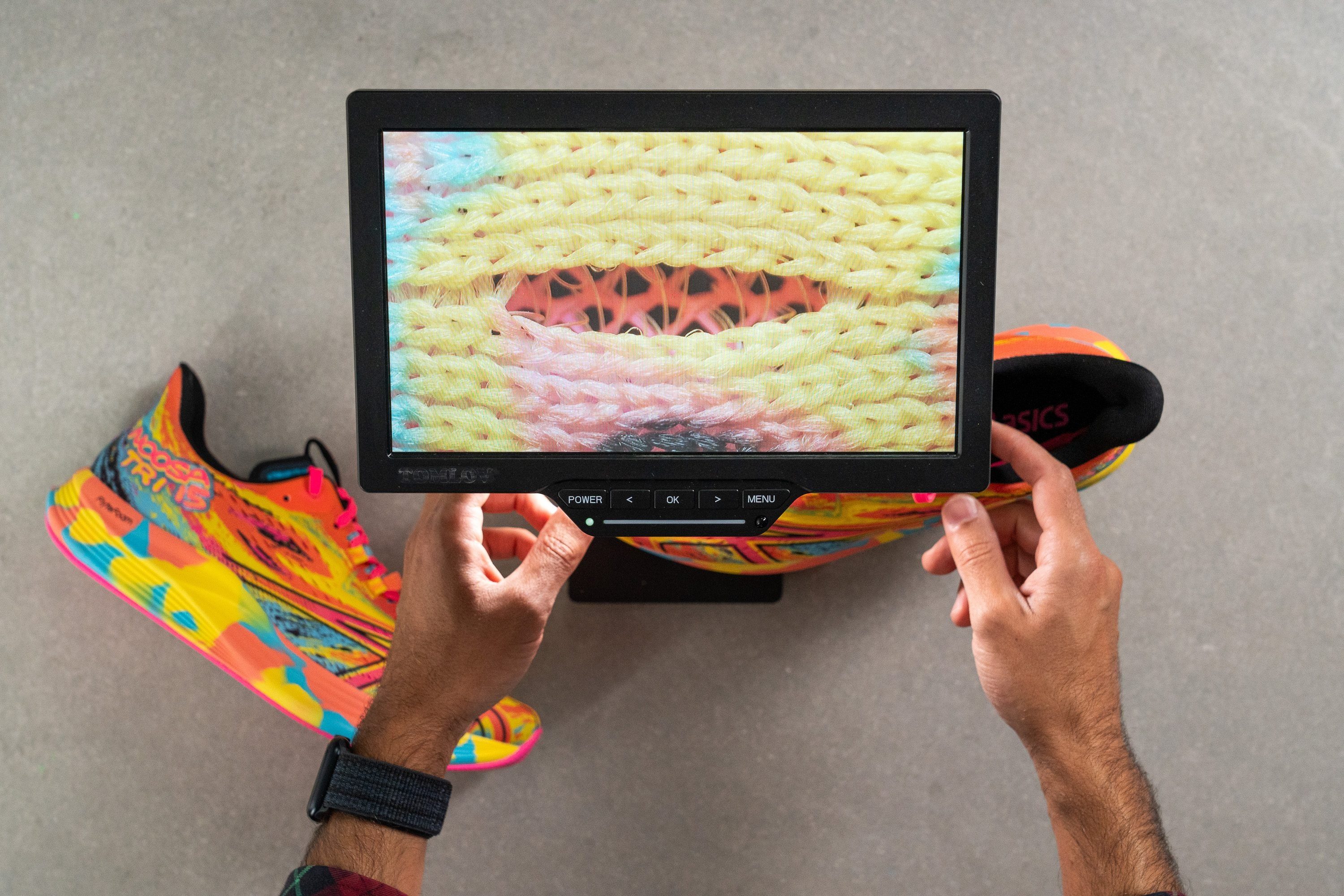
We further examine the breathability properties by looking at the upper under the microscope. This allows us to notice the ventilation holes, their size, second and third layers, the density of the threads, and so on.
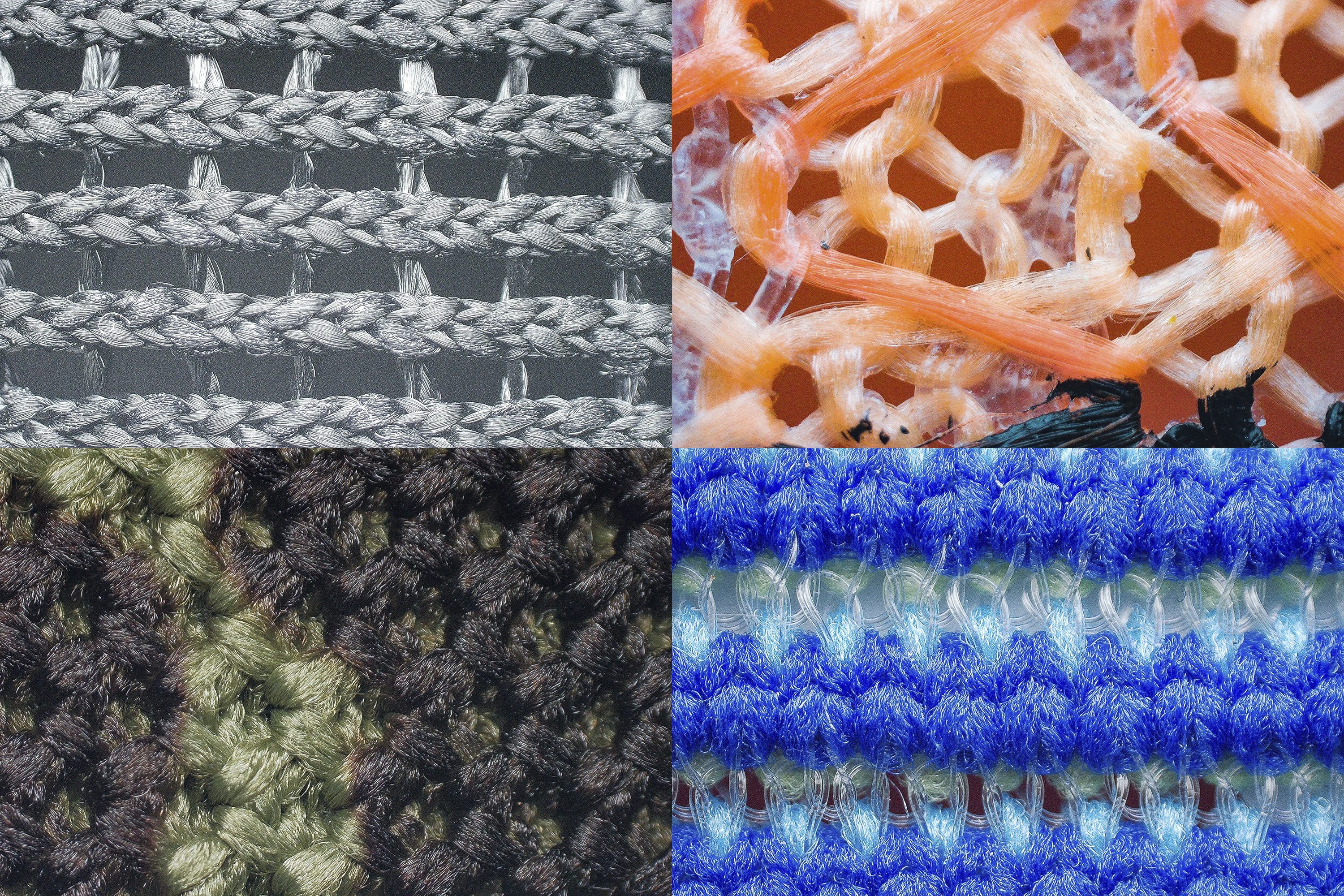
Look for a good tongue in triathlon running shoes
A good tongue for triathlons is most often a thin one that does not bunch up. But, a too-thin tongue can cause a lace bite! Then what? It’s on you to find the perfect middle. Gussets might also trouble you if you’re going sockless.
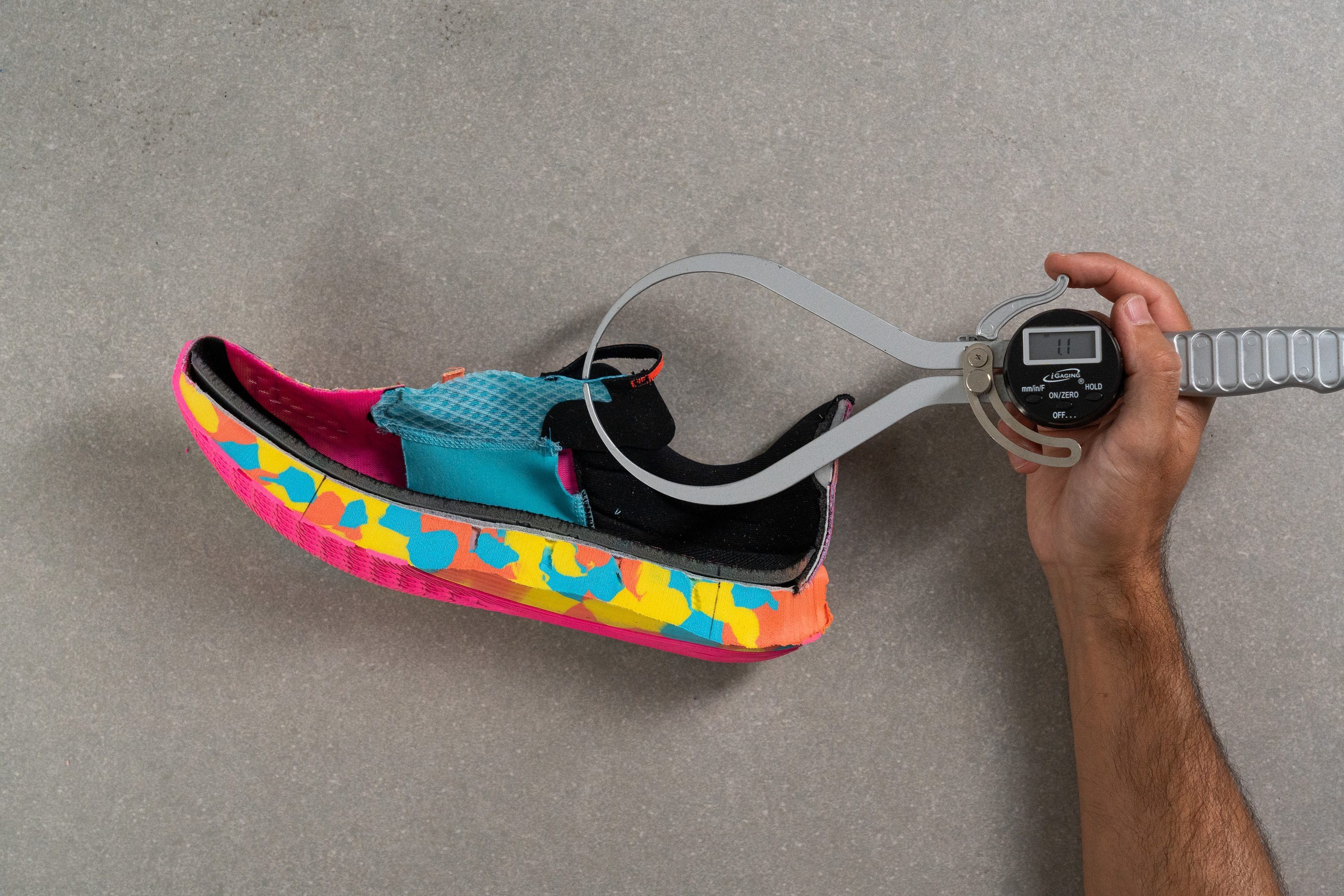
We always measure the thickness of the tongue and note whether it’s gusseted (connected to the sides under the eyelets) or not.
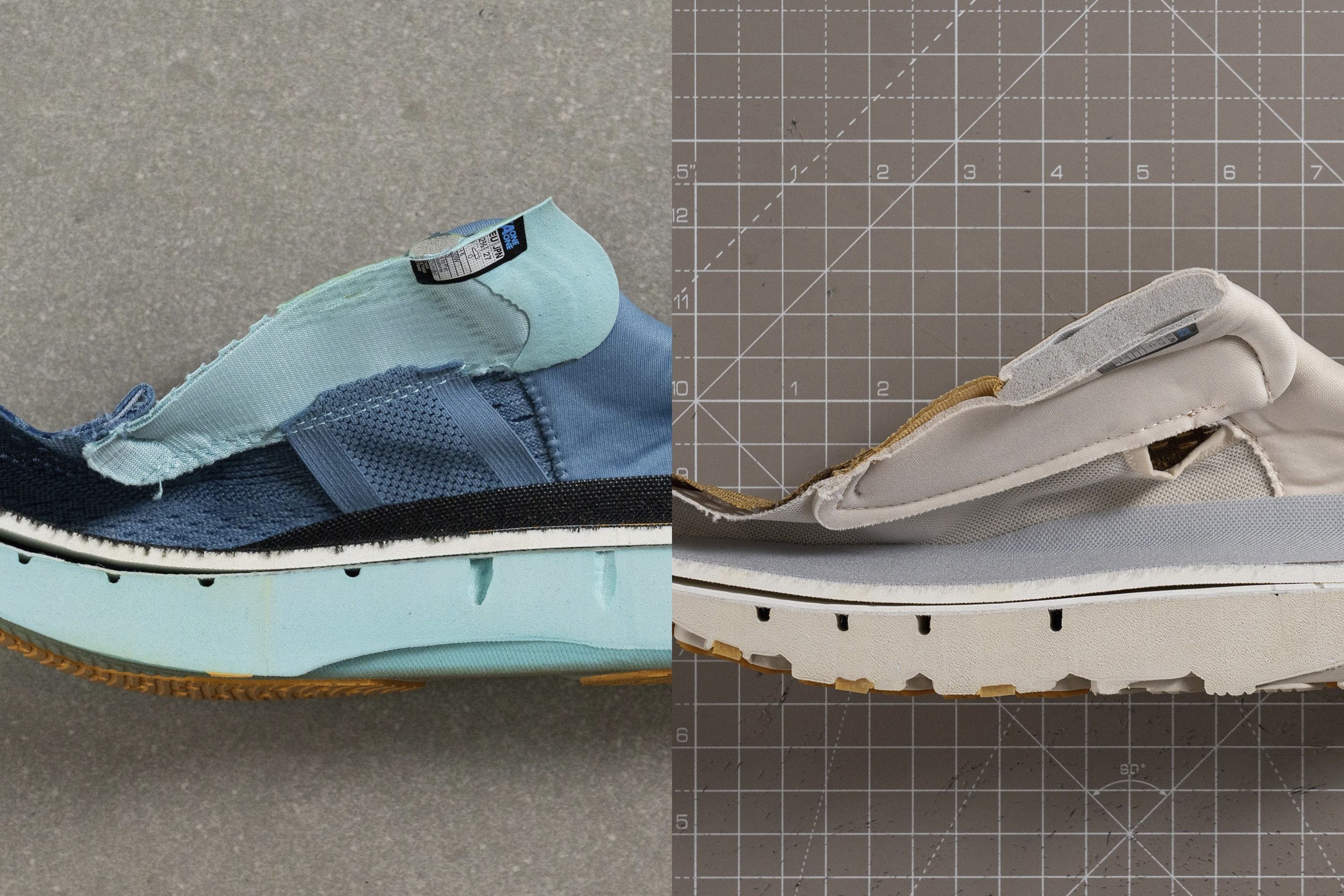
When NOT to buy carbon-plated tri shoes
If you’re planning to walk a certain part of the running distance, don’t buy carbon-plated running shoes. Shoes with a carbon-fiber plate are not comfortable to walk in and are too weird at slow paces. They will work against you instead of for you.
There are shoes to choose from that do not feature a carbon-fiber plate (like Asics Noosa Tri 16 or its predecessors, Saucony Endorphin Speed 3 or Speed 4, which both feature a nylon plate, etc.). Of course, we don’t always PLAN for walking the distance, but if feel like you might, better to be safe than sorry.
ILLEGAL triathlon running shoes
In 2023, World Triathlon added a section to their competition rules (page 61) stating that they follow the shoe regulations from World Athletics. Many runners take a risk and run in, for example, Superblast. Shoe checks might not be performed at every triathlon event, especially for participants who don’t get to the podium.
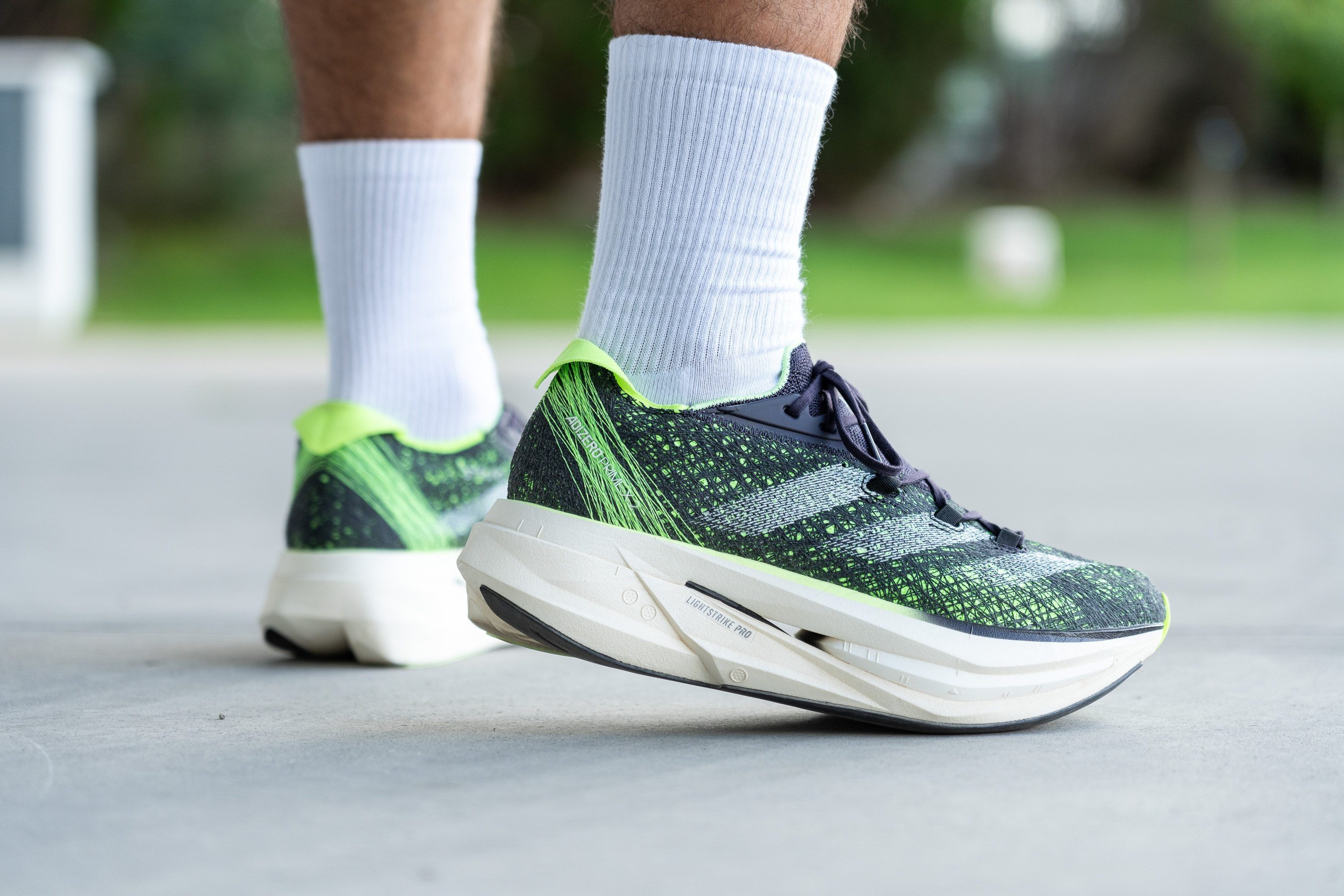
Since Jan 1, 2023, Ironman started following the guidelines from WorldAthletics, so now their competition rules (page 23) say that:
- Shoes with a heel stack height greater than 40mm are prohibited and will result in disqualification.
- Shoes with more than 1 plate rigid structure are prohibited and will result in disqualification.
They even keep a list of prohibited running shoes here.
What if it’s raining?
If the forecast says rain, adapt. Best to look for running shoes with a great grip.

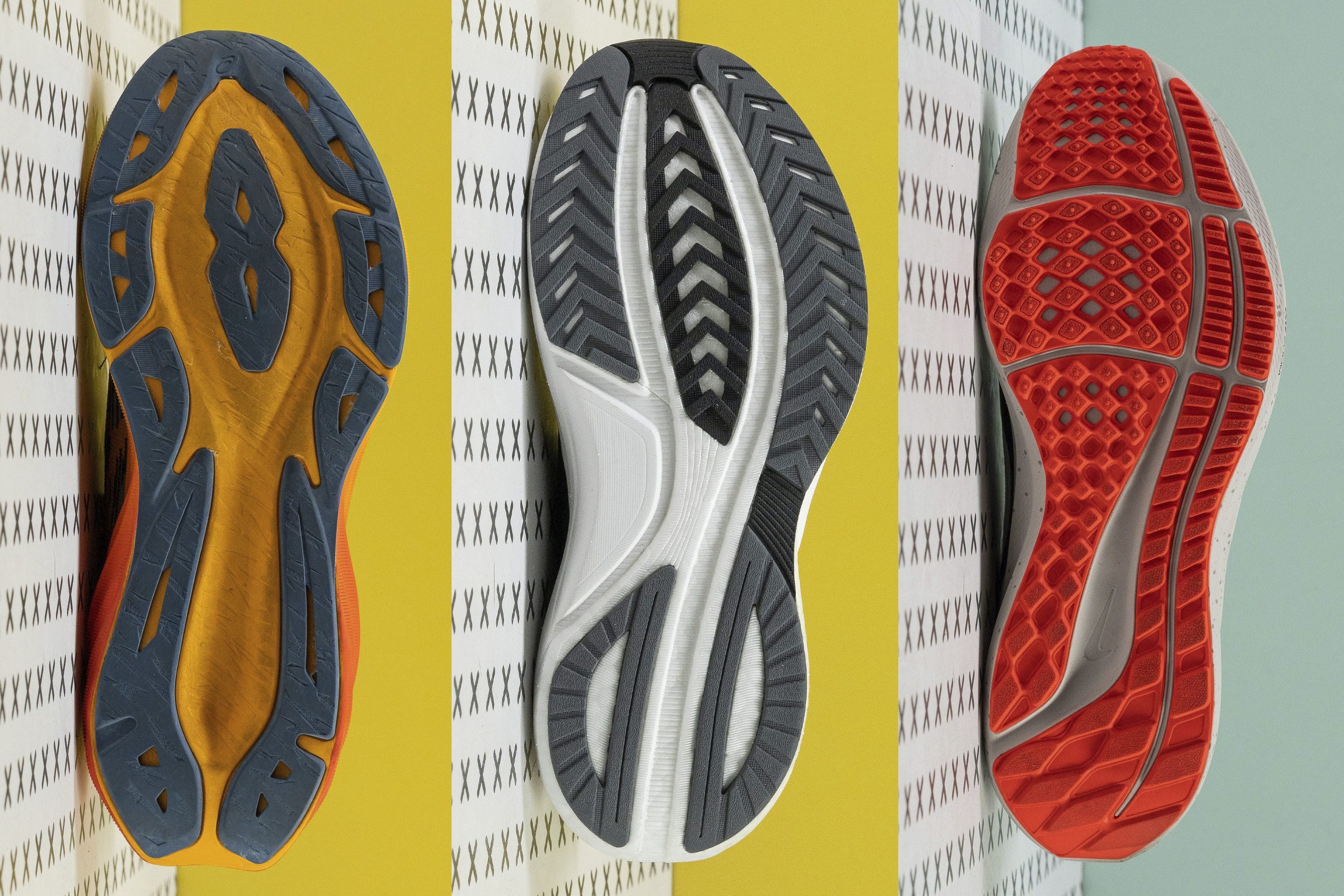
In the world of road shoes, that means a lot of grooves and channels and no exposed midsole. We also have a faster way of figuring it out: thanks to our standardized traction test performed in the lab.
Performing the traction test honoring the SATRA TM144 methodology
We perform this test in so-called critical conditions = on the wet surface. The result is a number that represents a dynamic coefficient of traction and, of course, the higher it is, the better for rainy runs!

